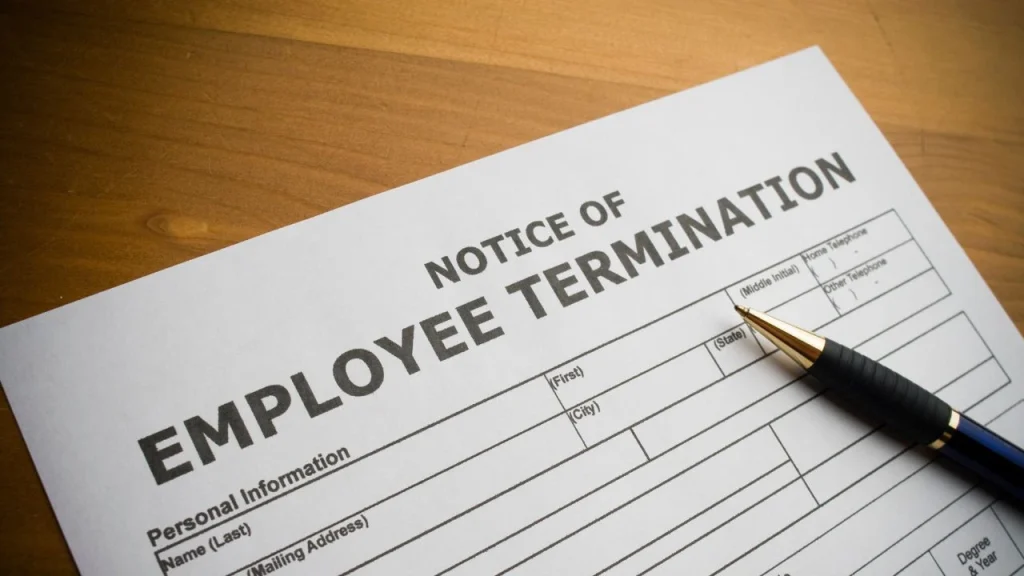Introduction: Don’t Let a Legal Misstep Cost You Everything
Firing someone or an employee termination is never easy. But doing it wrong? That can cost your company lakhs in compensation, legal battles, and even reputation damage.
In India, employee termination is heavily governed by labour laws. Whether you’re a startup founder, an HR manager in manufacturing, or a business owner handling your first firing, one mistake can land you in court.

Let’s walk through how to terminate employees legally, ethically, and safely—without putting your business or your HR career at risk.
Understanding the Legal Framework for Employee Termination
In India, employee termination is guided by:
- The Industrial Disputes Act, 1947
- Shops and Establishments Act (varies state-wise)
- Company-specific Standing Orders or HR Policies
- Contractual Employment Terms
Key Concepts You Must Know:
- Workman vs Non-Workman: Only “workmen” under ID Act get special protection
- Notice Period: Mandatory unless terminated for proven misconduct
- Retrenchment Compensation: Required in certain layoffs or role redundancy
Types of Employee Termination and the Right Way to Handle Them
- Termination for Misconduct
- Process: Hold a domestic enquiry → Issue charge sheet → Suspension with pay → Opportunity to be heard → Final termination order
- Example: Theft, violence, willful insubordination
- Legal Requirement: Natural justice must be followed
- Termination for Poor Performance
- Use PIP (Performance Improvement Plan) documentation
- Minimum of 2–3 review cycles recommended
- Share feedback in writing; avoid sudden exits
- Redundancy/Layoffs
- Provide written justification, business rationale
- Pay retrenchment compensation: 15 days’ salary per completed year of service (for workmen)
- Government permission may be required in case of >100 workers (Factories)
- Resignation / Voluntary Exit
- Document the process through a resignation letter and exit checklist
- Accept resignation in writing
- Ensure Full & Final Settlement (FnF) is timely
Step-by-Step Employee Termination Process for HR
- Review Contract + Company Policy
- Collect Documentation – performance records, warnings, complaints
- Issue Show-Cause or PIP (if applicable)
- Conduct Domestic Enquiry (if needed)
- Serve Written Notice or Pay in Lieu
- Process FnF Settlement
- Deactivate Access + Collect Company Property
- Offer Relieving Letter + Experience Certificate
- File Statutory Returns (e.g., Form 10 for EPFO if needed)
Common Mistakes That Can Land You in Trouble
- Terminating without documentation
- Firing after verbal warnings only
- No domestic enquiry in case of misconduct
- Not paying gratuity or leave encashment
- Retrenchment without notice or compensation
Real-Life Case: How One Company Paid ₹12 Lakhs for Wrongful Employee Termination
A Delhi-based IT firm terminated an employee over “underperformance” with just a 7-day notice and no PIP record. The employee filed a labor complaint. The court found no documentation or domestic enquiry. The company ended up paying ₹12L as settlement + court fees—a costly lesson in improper HR handling.
👉 [Download Your Free HR Termination Checklist PDFEmployee Termination Checklist]
Best Practices for HR Teams
- Always give feedback in writing
- Use termination templates approved by legal
- Avoid emotional triggers—be professional and neutral
- Involve legal counsel for sensitive terminations
- Use an exit interview to understand risks and collect feedback
Conclusion: Employee Termination Done Right Protects Everyone
Termination isn’t just about ending a job. It’s about protecting the company, supporting the departing employee, and staying legally compliant.
Follow the law. Respect the individual. And above all—document everything.
Want a copy of a legally compliant Termination Checklist used by top HR professionals?
FAQs: Legal Employee Termination in India
Q: Can I terminate an employee during probation?
A: Yes, but follow the contract terms and issue a written notice (typically 7–15 days).
Q: Is notice period mandatory for misconduct terminations?
A: Not if misconduct is proven through a domestic enquiry.
Q: What documents should I issue after termination?
A: Relieving letter, experience certificate, FnF settlement slip, EPF transfer/withdrawal details.
Q: Can an employee refuse to leave if terminated?
A: If all legal steps are followed, refusal won’t stand. Still, avoid confrontation—seek help if needed.
If your organisation requires expert guidance on legally compliant employee terminations, HR Expert Advisors is here to assist. Our services are designed to minimise the risk of costly litigation while ensuring fair and lawful practices. Reach out to us for trusted support in navigating complex HR decisions.

